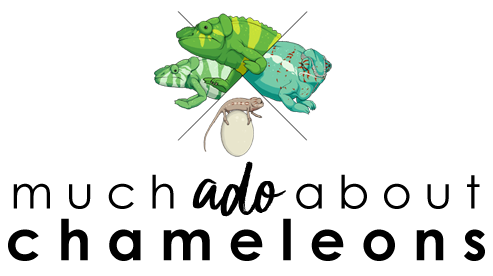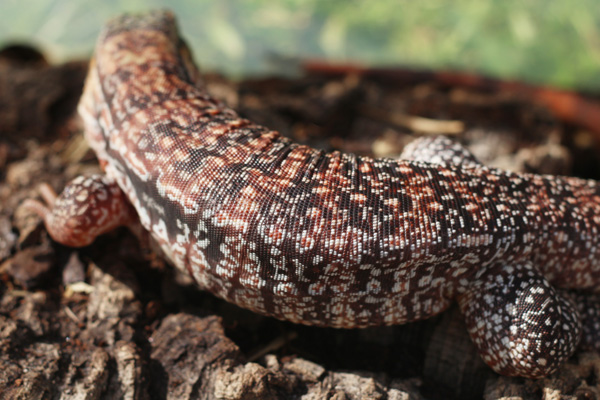This is a blog entry that I've been meaning to put together for a long time, and I was finally able to. I want to show you how to administer medicines properly, just in case your vet does not show you (always make sure that your vet shows you when they prescribe anything, though) or if you have doubts about how best to do it once you get home. We all know chameleons get stressed and unfortunately giving them needed medication is not something they're going to enjoy. But there are certain ways to do it to minimize the ordeal for them.
OPENING THEIR MOUTHS
There are a lot of techniques on how to best open a chameleon's mouth, and certainly some work better on some chameleons than others. I try to avoid using an object to pry open the mouth (like a pop-sickle stick or credit card.) For the majority of chameleons putting a finger on each of their head from behind and applying a little pressure (illustrated below) will cause them to gape in response.
Some chameleons (especially after they've experienced this trick a few times) will keep their mouth tightly clamped shut, so at that point I will take two fingers from my free hand, grab a pinch of skin from their gular area, and gently but firmly apply pressure downwards, and usually they will let go and open wide.
NOTE - Note in the illustration above where I have marked off the airway opening. You'll notice that it's in the middle of the mouth, and not in the back with the throat! This is why you'll see me recommend that any liquid medicine or food be squirted FAR into the mouth, to avoid having it pool at the airway opening and risk aspiration. I often see people squirt water into the mouths of sick or dying chameleons and I fear they are unknowingly causing more harm than good by putting water in the mouth of a weak animal, and accidentally getting it into their lungs.
HOW TO APPLY ANTIBIOTIC OINTMENT TO THE MOUTH AREA
If your chameleon ever needs to be treated for an oral infection, for example, your vet will probably send you home with antibiotic ointment. Now that you have the mouth open you will want to use something like a Q-tip, scoop up some of the ointment, and apply it thoroughly to the affected area as directed by your vet. In serious stomatitis/mouth rot scenarios you may need to apply it to the entire gum area. Additionally, if the infection is resulting in bacterial build-up (and probably some caking of old ointment) it's a good idea to take a clean Q-tip and gently clean out the mouth first so that the medicine can reach the affected areas.
HOW TO GIVE LIQUID MEDICINE
You have a few options when giving liquid medicine, such as antibiotics or liquid calcium. Which method you use may depend on the personality of your chameleon.
1. Inject the medicine directly down the throat with a plastic syringe
This is the most stressful of the options, but in some cases may be the only way. With the chameleon's mouth open, take your syringe (which has been pre-filled with medicine, so you're ready to go) and place the tip far back into the mouth. Making sure that whoever is holding the chameleon has it tilted slightly upwards, squirt the medicine, and withdraw the syringe. If the quantity is substantial it may be safer to do it in small amounts, so the chameleon can swallow in between.
2. Inject the dose directly into feeder insects.
Your vet will be happy to give you a syringe with a needle if you explain you're going to use this strategy. The dose has to be small for this to work, obviously, and the chameleon has to be a reliable hand-feeder. But I usually take something like a roach nymph or a large cricket with tong and hold it belly-up. Then with the needle I will go in from the lower abdomen towards the head until I am in the middle of the abdomen, and then slowly inject. The insect will not live very long so it's important to feed it off immediately! This is the most stress-free method for chameleons that will take food from their owners.
3. Slip in the plastic syringe tip into the corner of their mouths while chewing food.
This is another low-stress method, but will only work on larger chameleons. But while the chameleon is chewing a tasty insect use the plastic syringe, and with the agility of a ninja inject the dose into the mouth between chews. Some chameleons become suspicious if you hover with a syringe so this method is hit or miss with me personally.
HOW TO GIVE EYE OINTMENTS
If you have to treat a chameleon for an infection or injury that requires ointment directly into the eye, I don't usually like to use a Q-tip, just to not get any filaments into the eye. If the eye requires cleaning it is safest if your vet shows you how to do it properly. But as far as applying ointment into the eye I prefer to use one of my fingers (typically the pinkie finger, since it's smaller).
NOTE - This goes for any time you handle any injuries or infections, but particularly if you're going into their eye make sure your hands are clean! If you prefer, you can always use non-powdered gloves.
I will squirt the dose onto the tip of my finger and holding the head gently, will wait until the affected eye is open and dab the ointment into the eye gently. I will then very gently (and without pressure) rub the closed eye, making sure to not just cover the external eyelids immediately around the eye with ointment as well but to make sure the blob I just deposited inside is spread around properly.
Most chameleons, since their eye is generally itchy and uncomfortable from an infection, will appreciate the gentle rubbing and may even lean into it.
HOW TO APPLY OINTMENT TOPICALLY TO A SKIN INJURY/INFECTION
If your chameleon has suffered a burn, an external injury, or is being treated for any type of skin infection anywhere on the body, the easiest and most effective way to do it is to apply these products at night while the chameleon is sleeping. Once your chameleon is nice and asleep, take a Q-tip, gauze, or a clean finger and gently apply any topical medication to the affected area. Odds are your chameleon will not wake up if the lights in the room are kept dim and you are gentle, and since it is night-time they will remain still for about 8 hours which means the medication will not be misted off, rubbed off, or melt off under a basking light.
If additional work is required on the injuries (such as deep cleaning of the tissues first) it might be a good idea to do that late in the evening and then apply the medication, so that shortly afterwards the chameleon will go to sleep and the medicine will have a chance to work better.
NOTE - Always wash your hands thoroughly after handling your chameleon!
















Fantastic entry today Olimpia! Everything is so easy to understand and your drawings are great! Thank you! :)
ReplyDeleteThanks Lauren!
DeleteWould have loved to have such a guide as a kid. Nice. Love the drawings. The one with the finger with the ointment towards the chameleon's eye is hilarious.
ReplyDeleteOh my goodness thank you so much!!! Great advice and Rango ( my chameleon ) has successfully been given his first lot of oral antibiotics at home.
ReplyDeleteThis is my first time i visit here and I found so many interesting stuff in your blog especially it's discussion, thank you. https://s3-us-west-2.amazonaws.com/hope4cancerreviews/index.html Hope 4 Cancer Reviews
ReplyDeleteSay bye bye now ed problem and enjoy your sexual life. Click here Vidalista 60
ReplyDelete